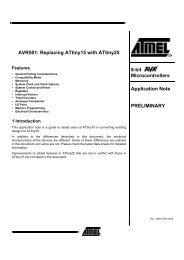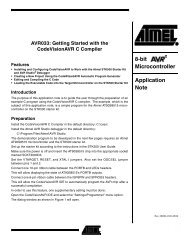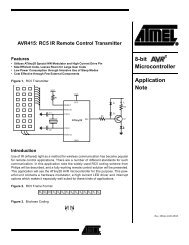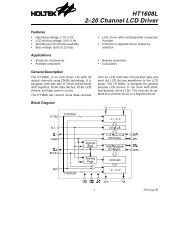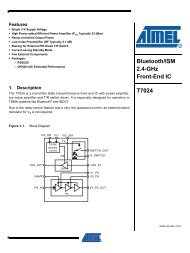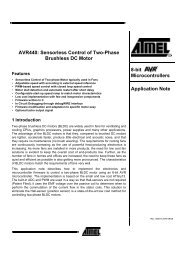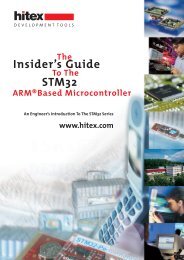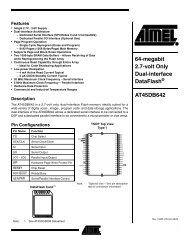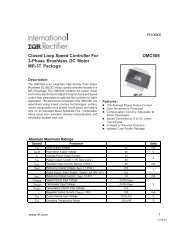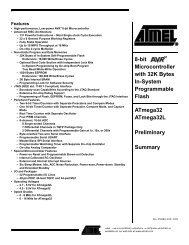Preliminary C8051F120/1/2/3 C8051F124/5/6/7 - KEMT FEI TUKE
Preliminary C8051F120/1/2/3 C8051F124/5/6/7 - KEMT FEI TUKE
Preliminary C8051F120/1/2/3 C8051F124/5/6/7 - KEMT FEI TUKE
Create successful ePaper yourself
Turn your PDF publications into a flip-book with our unique Google optimized e-Paper software.
<strong>C8051F120</strong>/1/2/3<br />
<strong>C8051F124</strong>/5/6/7<br />
<strong>Preliminary</strong><br />
21.2. Multiprocessor Communications<br />
Modes 2 and 3 support multiprocessor communication between a master processor and one or more slave processors<br />
by special use of the ninth data bit and the built-in UART0 address recognition hardware. When a master processor<br />
wants to transmit to one or more slaves, it first sends an address byte to select the target(s). An address byte differs<br />
from a data byte in that its ninth bit is logic 1; in a data byte, the ninth bit is always set to logic 0. UART0 will recognize<br />
as “valid” (i.e., capable of causing an interrupt) two types of addresses: (1) a masked address and (2) a broadcast<br />
address at any given time. Both are described below.<br />
21.2.1. Configuration of a Masked Address<br />
The UART0 address is configured via two SFR’s: SADDR0 (Serial Address) and SADEN0 (Serial Address Enable).<br />
SADEN0 sets the bit mask for the address held in SADDR0: bits set to logic 1 in SADEN0 correspond to bits in<br />
SADDR0 that are checked against the received address byte; bits set to logic 0 in SADEN0 correspond to “don’t<br />
care” bits in SADDR0.<br />
Example 1, SLAVE #1 Example 2, SLAVE #2 Example 3, SLAVE #3<br />
SADDR0 = 00110101 SADDR0 = 00110101 SADDR0 = 00110101<br />
SADEN0 = 00001111 SADEN0 = 11110011 SADEN0 = 11000000<br />
UART0 Address = xxxx0101 UART0 Address = 0011xx01 UART0 Address = 00xxxxxx<br />
Setting the SM20 bit (SCON0.5) configures UART0 such that when a stop bit is received, UART0 will generate an<br />
interrupt only if the ninth bit is logic 1 (RB80 = ‘1’) and the received data byte matches the UART0 slave address.<br />
Following the received address interrupt, the slave will clear its SM20 bit to enable interrupts on the reception of the<br />
following data byte(s). Once the entire message is received, the addressed slave resets its SM20 bit to ignore all transmissions<br />
until it receives the next address byte. While SM20 is logic 1, UART0 ignores all bytes that do not match the<br />
UART0 address and include a ninth bit that is logic 1.<br />
21.2.2. Broadcast Addressing<br />
Multiple addresses can be assigned to a single slave and/or a single address can be assigned to multiple slaves,<br />
thereby enabling "broadcast" transmissions to more than one slave simultaneously. The broadcast address is the logical<br />
OR of registers SADDR0 and SADEN0, and ‘0’s of the result are treated as “don’t cares”. Typically a broadcast<br />
address of 0xFF (hexadecimal) is acknowledged by all slaves, assuming “don’t care” bits as ‘1’s. The master processor<br />
can be configured to receive all transmissions or a protocol can be implemented such that the master/slave role is<br />
temporarily reversed to enable half-duplex transmission between the original master and slave(s)..<br />
Example 4, SLAVE #1 Example 5, SLAVE #2 Example 6, SLAVE #3<br />
SADDR0 = 00110101 SADDR0 = 00110101 SADDR0 = 00110101<br />
SADEN0 = 00001111 SADEN0 = 11110011 SADEN0 = 11000000<br />
Broadcast Address = 00111111 Broadcast Address = 11110111 Broadcast Address = 11110101<br />
Where all ZEROES in the Broadcast address are don’t cares.<br />
Note in the above examples 4, 5, and 6, each slave would recognize as “valid” an address of 0xFF as a broadcast<br />
address. Also note that examples 4, 5, and 6 uses the same SADDR0 and SADEN0 register values as shown in the<br />
examples 1, 2, and 3 respectively (slaves #1, 2, and 3). Thus, a master could address each slave device individually<br />
using a masked address, and also broadcast to all three slave devices. For example, if a Master were to send an<br />
address “11110101”, only slave #1 would recognize the address as valid. If a master were to then send an address of<br />
“11111111”, all three slave devices would recognize the address as a valid broadcast address.<br />
Page 258<br />
DS008-0.8-AUG02 © 2002 Cygnal Integrated Products, Inc.



